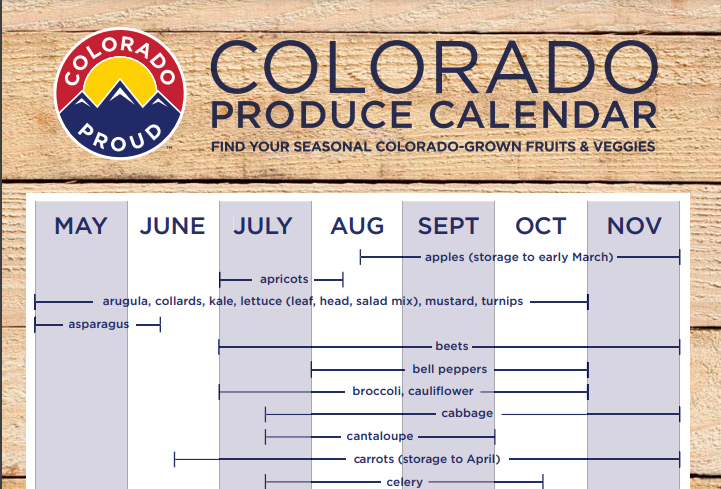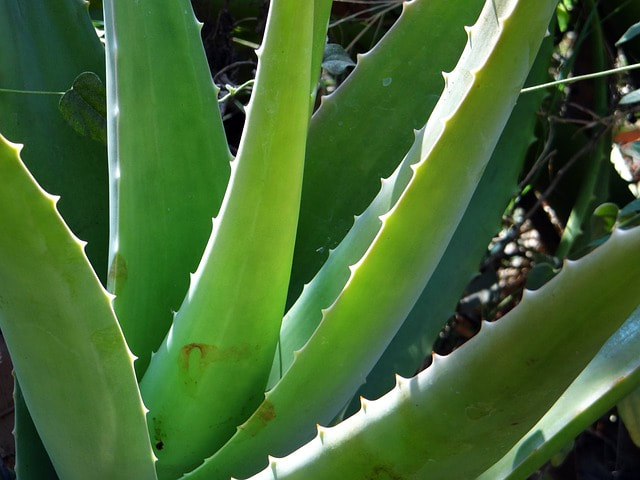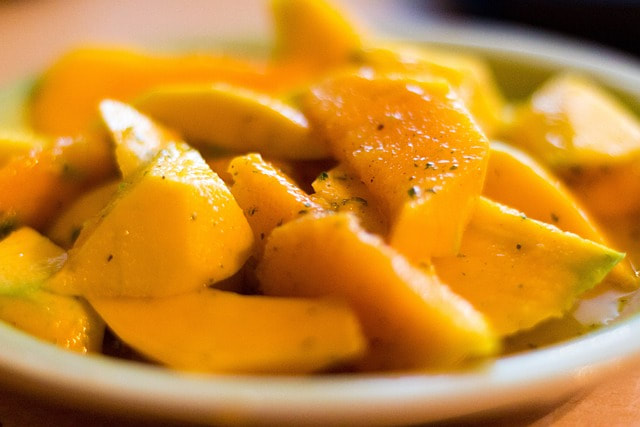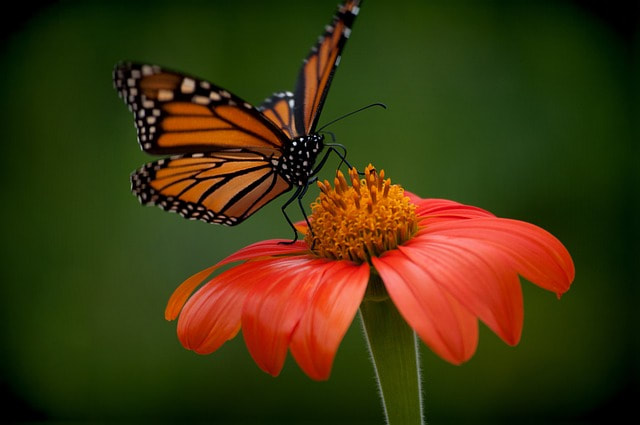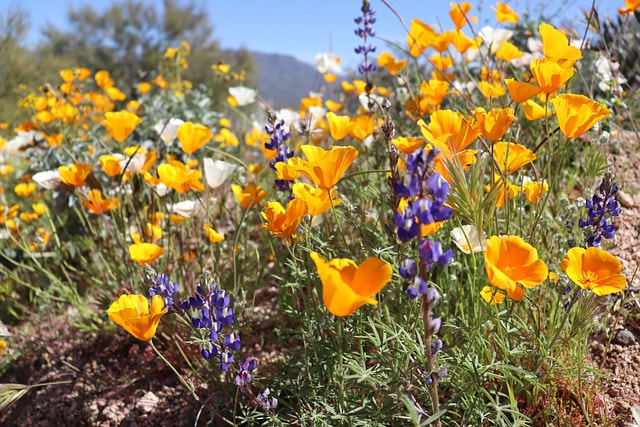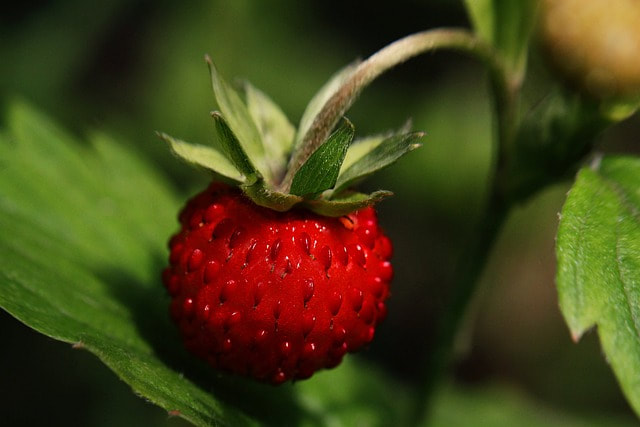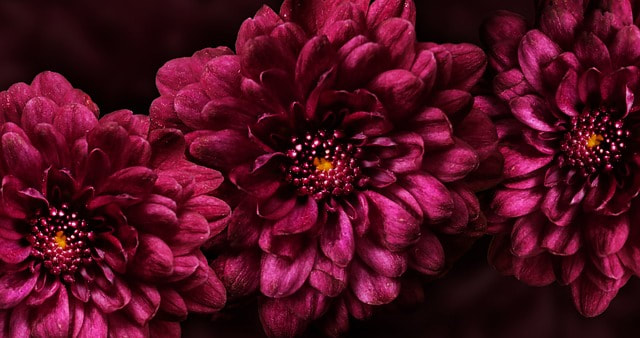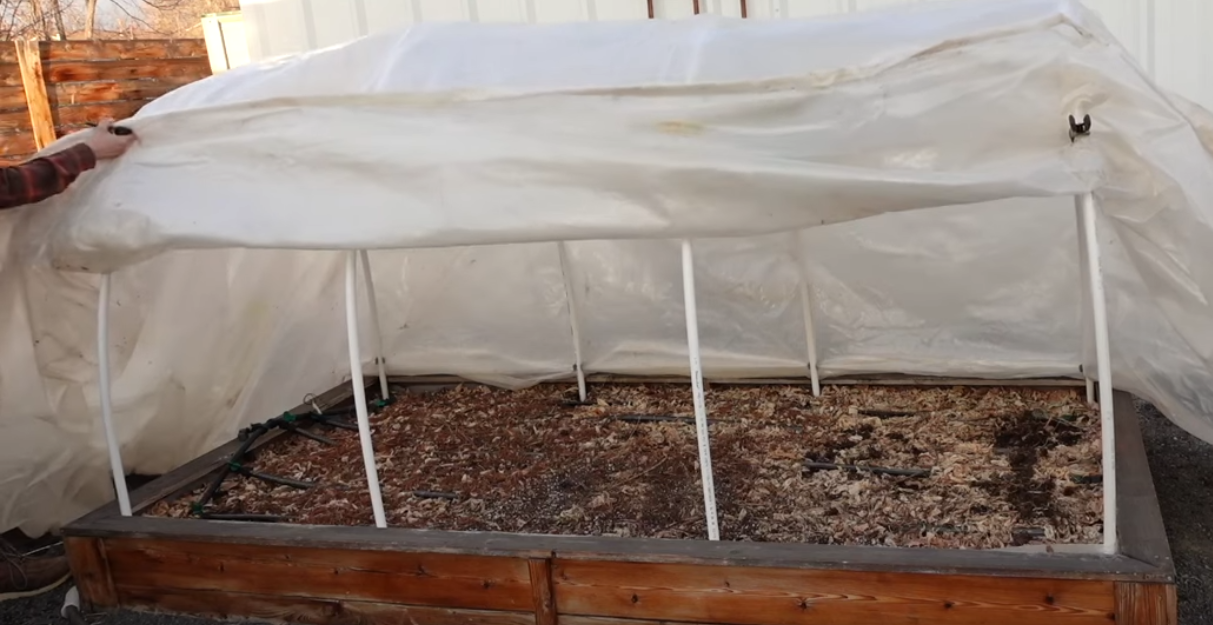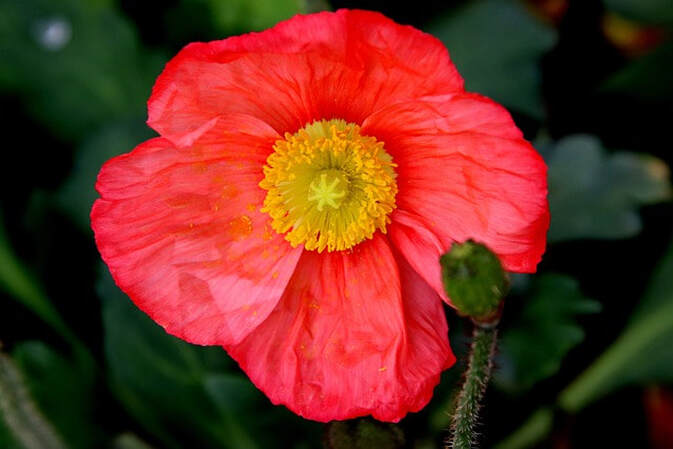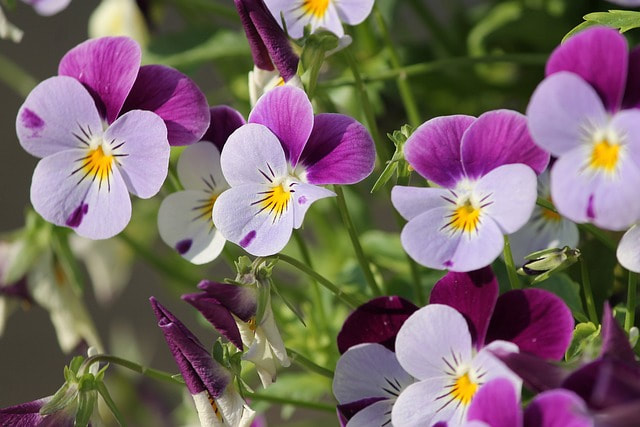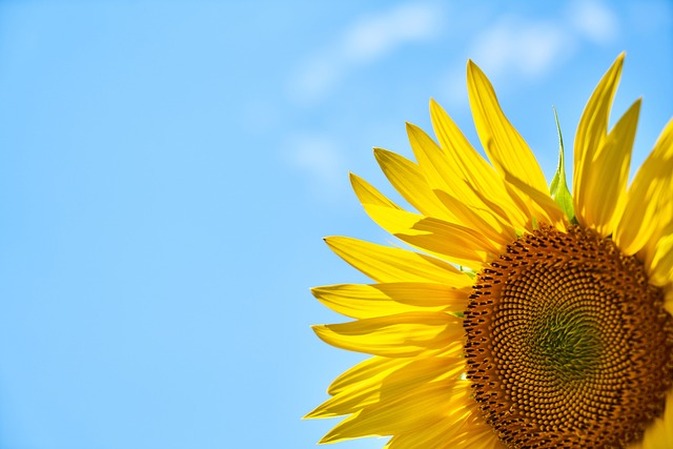Click here to see the full calendar.
|
This is a nifty offering from Colorado Proud: a calendar of what produce grows when in our State. Great for cooking with seasonal fruits and veggies to save big on produce that is in season and readily available.
Click here to see the full calendar. "No matter how long the winter, spring is sure to follow."Just as winter eventually gives way to spring, difficult times will eventually pass and be replaced by more positive circumstances.
This proverb encourages patience, perseverance, and faith in the cycles of nature and life. Using an herb saver can help you save money and reduce food waste by keeping your herbs fresh for longer.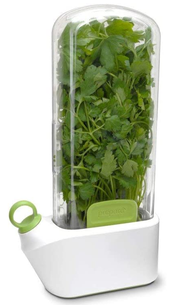 An herb saver is a kitchen tool designed to help keep fresh herbs fresher for longer. It usually consists of a container with a lid and a tray or basket that holds the herbs. The container is designed to keep the herbs fresh by providing a moist environment and protecting them from air and light. The tray or basket in the herb saver is designed to keep the herbs upright, allowing their stems to rest in water, which keeps them hydrated and fresh. The container's lid helps to seal in moisture and prevent air from entering, which can cause the herbs to wilt and spoil. With the Prepara model shown at left you fill the bottom with fresh water every 3 to 5 days. The link for this model is below. Some people recommend freezing herbs but that defeats the purpose of fresh herbs for cooking! Using an herb saver, your herbs should last 7 - 12 days longer. To keep your pets safe in a home with indoor plants, remember this list of toxic plants and their healthy-for-pets replacements, courtesy of Real Simple's article here (the article includes great photos of each plant).
Credit: Real Simple It's easy to reach for the scissors when cutting floral stems, but scissors are actually terrible for cutting flowers (and any other plant or shrub). Scissors squeeze the stem of the live material you are wanting to cut (kind of like squeezing a straw), which then inhibits the flow of water needed to keep the bloom at the top of the stem alive. If the water flow isn't optimal, the plant or floral stem will suffer (and show it). The best tool for cutting small the soft stems of flowers and thin shrub branches is a bypass pruner (see photo). Bypass pruners work by using two blades that bypass each other when they cut. The blades of bypass pruners are made of hardened steel and are very sharp, which allows for clean and precise cuts. The blades are typically curved, which helps them grip the branch or stem being cut and prevent it from slipping out of the blades. When using bypass pruners, the user places the stem or branch to be cut between the two blades and squeezes the handles together. As the handles are squeezed, the blades bypass each other and cut through the branch or stem, leaving a clean cut. Bypass pruners are typically used for pruning small branches and stems up to about 1 inch in diameter. They are a popular tool for gardeners and landscapers because they are easy to use, lightweight, and allow for precise cuts. They are also available in a range of sizes and styles to suit different types of pruning tasks. The best bypass pruners reviewed here. Black Forest Garden Club will include a brand new pair of Ronix bypass pruning shears in our April gift basket. Our April event is on April 20th. See home page for details. Mangoes are very inexpensive right now. Here's a healthy, easy to-pull-together salad using mangoes as the main ingredient.First, a little about this yummy tropical fruit: Mango is rich in nutrients, including vitamin C, vitamin A, folate, and potassium. These nutrients can help support a healthy immune system, promote healthy vision, and maintain healthy blood pressure. They are rich in dietary fiber, which can help support healthy digestion and prevent constipation. Mango also contains enzymes that can aid in digestion and help break down proteins. Mangoes contain compounds called polyphenols which may contribute to lowering cholesterol. Mango is rich in vitamin C, which can help support healthy skin. Vitamin C is an antioxidant that can help protect the skin from damage caused by free radicals. Mango Avocado Salad by Kim Carson Cut and cube the following items: 1 Small Vidalia Onion (or half large) 1 Mango (Peel and Pit) 1 Avocado (Peel and Pit) 1 Tomato Place cubed items into a bowl- Add the juice of 1/2 lemon Season with the following to taste: Fresh ground Cumin Chili Powder Salt and Pepper Garlic Powder (or substitute 1 fresh pressed garlic clove) Mix – place in a bowl and garnish with Nasturtium Blooms Serve chilled - Serves 4 Find out more about Kim Carson and her healthy recipes at www.KimCarson.online Credit: Ubloom.com The easiest way to cut a mango - click here for video tutorial complete with great tips. Many gardeners desire to plant wisely to bring birds, bees, and butterflies to our gardens. We like the idea of gardening for good - not just gardening for gorgeousness.When you focus on a garden designed to benefit the local pollinator population, you get gorgeous AND you'll enjoy watching the wildlife that visits too. Here are some tips for growing a garden for pollinators: Choose a sunny location: Pollinators need plenty of sun to thrive, so choose a spot in your yard that receives at least 6 hours of direct sunlight per day. Select pollinator-friendly plants: There are many plants that are great for pollinators, including native wildflowers, herbs, and fruit trees. Choose a variety of plants that bloom at different times throughout the growing season to provide a steady source of nectar and pollen. See our recommendations here. Places for nest and rest (habitat): Pollinators need more than just food; they also need respite. Consider adding a bee house or providing a section of your garden with undisturbed soil for ground-nesting bees. Also provide a bird bath, fountain, pond, or other watering source for these important garden friends. Avoid pesticides: This is a big one! Pesticides can be harmful to pollinators, so try to avoid using them in your garden. If you do need to use pesticides, choose ones that are specifically labeled as safe for pollinators (click here for a list). Maintain your garden: Regular maintenance, including watering, weeding, and deadheading spent flowers, will help keep your pollinator garden healthy and thriving. It isn't difficult to create a beautiful and beneficial pollinator garden that supports the health of your local ecosystem! What plants can you plant in our area that will attract bees and butterflies and also allow them to thrive?Colorado has a dry and semi-arid climate, which means that plants that are drought-tolerant and can thrive in this environment are ideal for a pollinator garden. Here are some of the best pollinator garden plants for Colorado including their bloom season. Everything listed is deer-resistant.
It's best to choose a variety of plants that bloom at different times throughout the growing season to ensure that your pollinator garden provides food for pollinators all season long. Photos top row left to right: Bee Balm, Blanket Flower (Gaillardia daisy), Coneflower
Bottom row left to right: Penstemon, Yarrow (be sure to not plant the invasive kind), and Salvia.  Douglas Conserves is hosting a native plants workshop (in person) on April 6 from 5:30p - 7pm in Castle Rock. The workshop is FREE. For details, click here. Plant in image is the wonderful, native Rabbitbrush. A dry native garden is a type of garden that is designed to thrive in regions with low rainfall or limited access to water.This type of garden typically features plants that are native to the area and have adapted to the local climate conditions. The plants in a dry native garden are typically drought-tolerant and require minimal watering once established.
In addition to being environmentally friendly, dry native gardens can be visually appealing and require less maintenance than traditional gardens. Some common features of a dry native garden may include gravel or other types of mulch to help retain moisture in the soil, as well as rocks or other natural elements to add texture and interest to the garden. Dry native gardens are a sustainable and low-maintenance landscaping option for those living in semi-arid regions like ours. CSU Extension has an excellent guide called Low-Water Native Plants for Colorado Gardens. Our area is specifically included in the regions addressed by the guide. The purpose of this booklet is to introduce you to the wonderful world of dry native gardens, and to help you make the most successful landscape design and plant choices for this smart type of garden. The guide is available for free here. Growing strawberries is easy once you know how. Here's a primer on how to grow these nutritional powerhouses in your own garden.
Strawberries are about to come back into season! We love these tasty berries for the versatility as snacks and in recipes.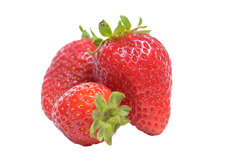 Did you know that strawberries provide a plethora of nutritious health benefits? Strawberries are high in nutrients - packed with vitamins and minerals, including vitamin C, folate, potassium, and manganese. They may improve heart health because they are rich in antioxidants and polyphenols, which may help to reduce inflammation and improve circulation, both of which are important for heart health. These sweet berries may lower blood pressure due to their high potassium content (beneficial for those with hypertension). And they may help prevent cancer with their various compounds that have been shown to have anti-cancer properties, including ellagic acid and anthocyanins. Other benefits to know about strawberries:
From magenta blooms to embracing native plants to quality over quantity - here's what's trending in the gardening space in 2023, according to Better Homes & Gardens:
For more details on each trend, click here. Credit: BHG.com Black Forest Garden Club's March event is next Thursday March 16th, 2023. In addition to learning all about the best way to begin your seedlings (growing mediums, optimal containers for good root formation, hardening off your little seedling babies) we'll have a seed swap and a garden basket packed with goodies including a dozen fresh eggs from member Jim's chickens, homemade raspberry jalapeno jam, bulbs for forcing, fresh seed packets, and more!
Enter the drawing as many times as you want ($3 per entry), and bring your seeds for the swap. Please make sure seeds are not expired, are clearly marked, and tested as viable. To test your seeds for viability, click how-to here. NOTE: the puppy in the photo is not part of the gift basket!  Growing bulbs indoors brings the elegance of beautiful flowers to your home. Forcing bulbs indoors brings color, fresh fragrance, and natural warmth to home environments. In the book Paradise Contained (William Stites, hardcover), bulbs are showcased through forcing so they flower indoors - one of the easiest and lovely ways to garden. No skills necessary - only water, a cool dark place, and a little patience! According to the book, "bulbs have a thrifty nature; each bulb already contains all it needs to survive. And many bulbs will flower year after year." The book has beautiful photos that offer suggestions for decorating with flowering bulbs using pretty containers and clever styling. The book may be from 1990 but it is still available online and resonates as relevant and timely today. To purchase (only $4.95 on Amazon!), click here. This time of year, many of us wish we had a greenhouse to pop our tender seedlings in to for hardening off or to get a head-start on growing. Now you can have a protected outdoor space with hardware store materials and only an hour of time.
This Longmont flower grower uses her raised beds as quick-and-easy greenhouses and they work great for a few degrees of extra protection. Here's how she does it: Materials you'll need for a 4 x 8' bed:
If the heater makes you nervous (remember, safety first!) this greenhouse without a heater will still give you an extended growing season with frost protection and a few degrees of extra warmth, especially if you use frost fabric within the structure. Want to make it even more efficient? Add a layer between the two plastic layers of bubble wrap for extra R value. Here's the 12-minute video with instructions on how to build your own DIY greenhouse. Credit: Blossom and Branch Farm Another option for protecting tender plants through the spring are these row covers from Gardener's Supply Company. One of our members swears by them (she puts a brick on each to keep them down due to wind). They have been used for four years in a row and are holding up well. TIP: buy the covers that include ends as shown in link or else cold air will get in and zap your plants. The FREE way to protect spring growing beds is to cover them with a thick layer of pine needles. Iceland poppies are a beautiful and beloved flower that bring a touch of charm and whimsy to gardens and floral arrangements. Sometimes called Arctic poppies, they are known for their delicate, papery petals and vibrant colors, ranging from pure white to yellow, pink, orange, and even red.
Iceland/Arctic poppies are cold-hardy plants, even with their delicate-looking blooms. These perennials are also are also excellent deer-resistant perennials. We don't recommend planting from seed (takes too long to get results) but instead purchase the perennials in the early spring from your favorite garden nursery. Light Likes lots of sunshine but will tolerate partial shade. Soil: Arctic poppies thrive in rich, well-draining soil. Water: Too much water may be the number one enemy to Arctic poppies. Soggy soil can lead to blight or fungus, which makes for unhappy poppy plants. They do like a consistent watering schedule but don't overwater. It's also important to avoid spraying water on the flowers and leaves, as the weight of the droplets can damage the delicate blooms. Fertilizer: This kind of poppy likes consistent and frequent fertilizing. Your poppies will appreciate consistent food every other week. Pruning To keep your poppies healthy and continually blooming, deadhead/remove old blooms. This encourages your poppies to produce more flowers. Soil microbes are microorganisms that live in the soil and play a crucial role in maintaining healthy soil ecosystems and supporting good plant health. If you till your soil as a means of springtime prep, you are disturbing and killing the most important things in the soil, and the growth of your plants and flowers will be lackluster. The benefits of soil microbes are well-proven
Basic Facts about soil microbes
Children who spend time in green settings have improved creativity, imagination, cognitive function, and intellect.  Did you know children who grow their own vegetables are five times more likely to eat them? Whether it’s at school or at home, gardening can benefit their health and well-being in many ways. Gardening connects us with Mother Nature, influences environmental stewardship and is an ongoing lesson in a healthy lifestyle and good nutrition. Consider involving your children in planning your garden, and garden alongside them when it’s time to plant. Let them select veggies, herbs and flowers they would like to grow. Get them involved early in the process to increase their investment and help them learn. Planning a garden can help them practice math skills and expose them to the science of plants. In the remaining winter days, plan your garden and invite kids to join you. You will all reap the benefits this summer and onward. Credit: ALCC Cheerful Johnny Jump-ups (Viola) brighten garden beds and pathways in early spring. They are one of the first flowers we see as winter wanes.
They are popular garden plants due to their brightly colored, dainty flowers, which come in a wide range of colors including yellow, orange, red, purple, blue, and white. The flowers are typically around 1 inch in diameter and have five petals, with the lower one often featuring a distinctive dark blotch or eye. Violas are very easy to grow and are tolerant of a range of growing conditions. They prefer cool temperatures and can often continue blooming throughout the summer and into the fall in our colder climate. They are commonly used in flower beds, borders, and containers, and are often paired with other cool-season annuals such as snapdragons, calendula, and alyssum. Violas are also edible and have a mild, slightly sweet flavor. The flowers can be used to add color and flavor to salads, soups, and other dishes. In addition, violas have been used in traditional medicine to treat a variety of ailments, including respiratory infections, skin conditions, and headaches. However, it is important to note that violas can cause allergic reactions in some people, so caution should be taken when consuming them. Violas have a mild wintergreen flavor and can be candied to use for decorating cakes and cookies. Try freezing them in ice cubs to dress up your drinks, or eat straight from the garden for a fresh treat. They reseed easily and are just as easily plucked out of spots where you don't want them. March 7 - Full Worm Moon. Worms do so much to improve the soil - from aeration to moisture retention, to structure and adding nutrients.
March 12 - Daylight Savings begins To attract goldfinches and other songbirds to your garden, plant sunflowers such as Aztec Gold and Mammoth Russian whose seeds are edible. When the North Star twinkles, expect stormy weather. Snow can host algae that tint it red, green, orange, yellow, or gray. Scatter poppy seeds on the snow. They'll germinate come spring.  Colorado State University Extension is offering a webinar on March 8, 2023 via Zoom on cold hardy cacti and succulents. In this webinar, you'll learn which cactus and succulents are best adapted for cold and freezing temperatures, what soils they like best, how to water, when to let them go dormant, and which varieties will give you the best performance year over year. To register, click here. The webinar begins at 12 noon MST. Photo shows Cholla cactus. |
AuthorsBlog posts are written by Kathy Sullivan, Communications Director. Contact BFGC: [email protected] Archives
July 2024
Categories
All
|
